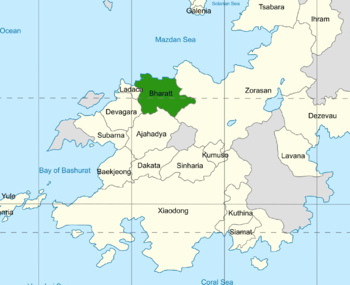Bharatt
THE KINGDOM OF BHARATT भरत राज (Bharatti) ભારતનુમ રાજ્ય (Himavantum) Bhāratanuṁ rājya | |
|---|---|
|
Flag | |
| Motto: "Jai Bharatt" Hail Bharatt (English) | |
 | |
| Location | Continent of Coius |
| Official languages | Bharatti |
| Recognised national languages | Zubadi, Himavantan, Sataristani |
| Ethnic groups |
|
| Religion | Hindyism |
| Demonym(s) | Bharatti |
| Government | Federal, Parliamentary, Constitutional Monarchy |
• Monarch | King Raja VII |
• Crown Prince | Prince Akash |
• Prime Minister | Madhava Thakur |
• Lord Chief Justice | Vishnu Kapadia |
| Legislature | Parliament of Bharatt |
| Rajya Sabha | |
| Lok Sabha | |
| Significant events & Formation | |
• Vikasan Era | 100 BCE - 500 CE |
• Unknown Crown Rule begins | 19th June, 1748 |
• Independence from Unknown | 14th November, 1953 |
| Population | |
• 2019 estimate | 98,156,316 |
• 2017 census | 96,165,614 |
| GDP (nominal) | estimate |
• Per capita | $24,516 |
| Currency | Rupee |
| Time zone | UTC-2 |
| Date format | dd/mm/yyyy |
| Driving side | left |
| Calling code | +52 |
| Internet TLD | .bh |
Bharatt, officially the Kingdom of Bharatt, is a country on the continent of Coius. Bound by the Mazdan Sea on the North, Bharatt shares land borders with Zorasan to the east; Ajahadya to the south; and Devagara and Ladaca to the west.
Humans first arrived on the continent thousands of years ago and initially began to occupy the land as hunter-gatherers, forming numerous different clans. Many of these clans would, in later generations, begin to settle along the river Bhar and over thousands of years would begin to form the Bhar River Civilisation. This civilisation would develop a now ancient language of Bhasa which would bind the cultures of the Bhar River Civilisation together through a shared language, although these individual clans would remain distinct in other regards. The Bhasa language would record the foundings of the Hindyism religion and be used to document its sacred texts. By 500 BCE, the clans of the Bhar River Civilisation had begun to consolidate politically which led to the formation of various Kingdoms and Empires in the Bhar River basin. These Kingdoms and Empires would continue to develop for hundreds of years and with their development came an era of creativity, cultural development and religious enlightenment. This period would become known as the Vikasan era.
In modern Bharatt, the historical clans of the past still have considerable influence. Although many clans would join together during the Vikasan era, they retained their clan structures and the new Kingdoms and Empires would become collections of clans rather than blending clans together. In modern Bharatt, Clans have become societal groups with people of the same Clan often being from the same religious predisposition and living in the same states and cities. Most Clans have also retained their leading families which has resulted in the leaders of the Clans still retaining incredible influence within Bharatti society. As a result of this, the leaders of all of the recognised clans of Bharatt are granted seats in the Rajya Sabha (upper house of the Parliament).
Bharatt has been a federal constitutional monarchy since independence in 1953, governed via a democratic parliamentary system which retains heavy influence from the Crown and Nobility. The nation is predominantly Hindyist and its population has steadily grown alongside its economy. From being a colonial possession in the 1900s, modern Bharatt has progressed rapidly and is now a world leader in clean, renewable energy and agricultural practices. The domestic culture of Bharatt has also seen a modern renaissance with the nation developing its own large scale domestic entertainment and music industry. Bharatt has also seen a re-emergence of its precolonial architecture since independence and its society and institutions have reverted in many ways back to the ways of pre-colonial society; rejecting social constructs and repressive policies enforced by colonial powers. Bharatt still retains much of its colonial heritage; the railway networks, education system, style of government and welfare programmes have all been expanded upon and developed from the original colonial foundations.
